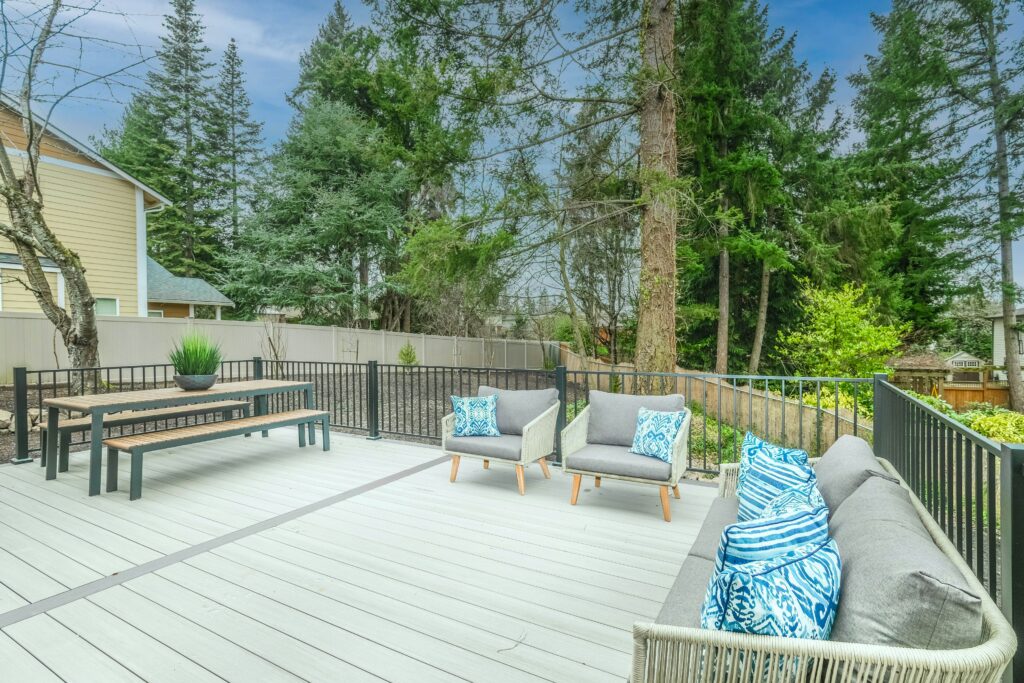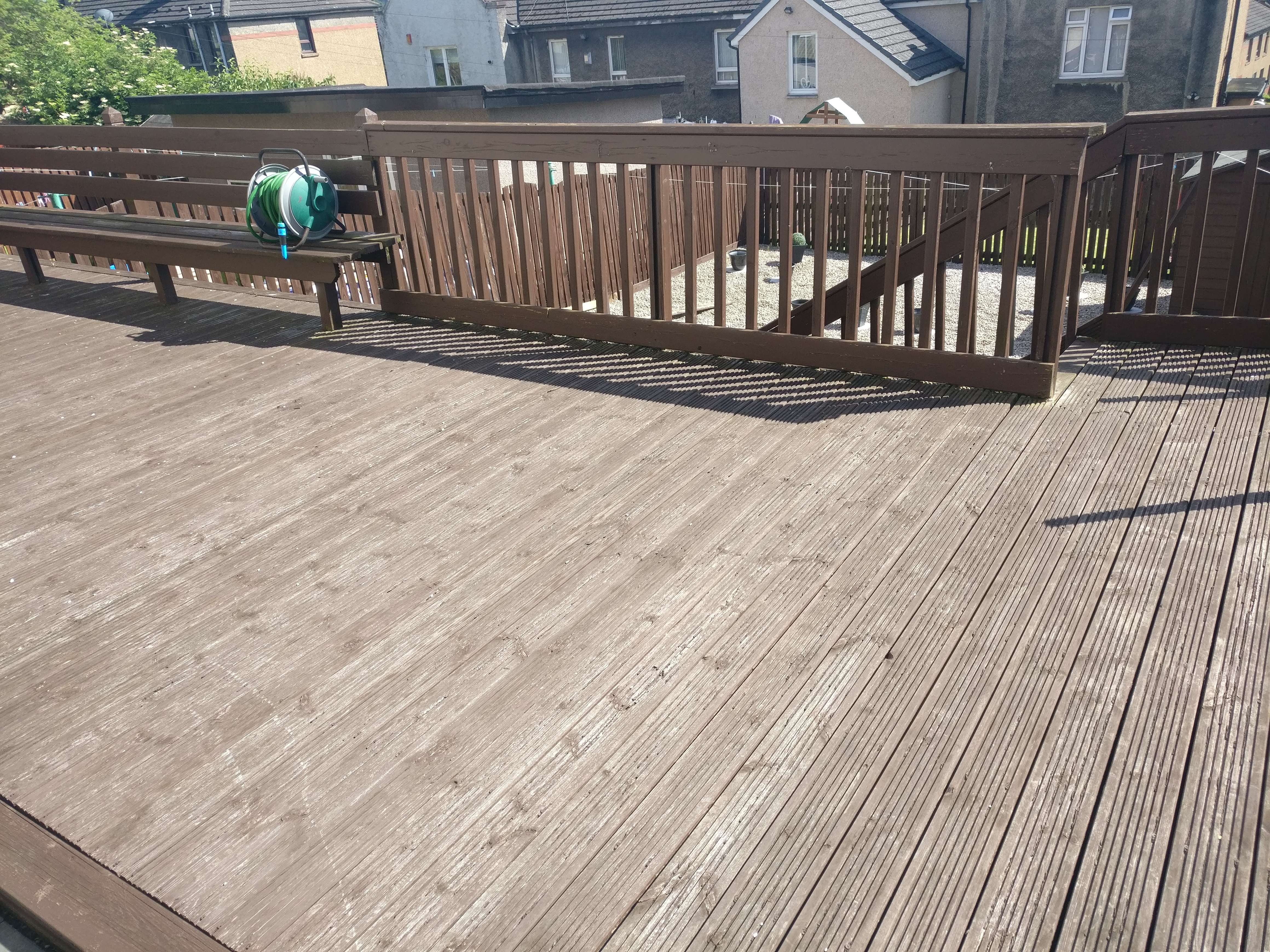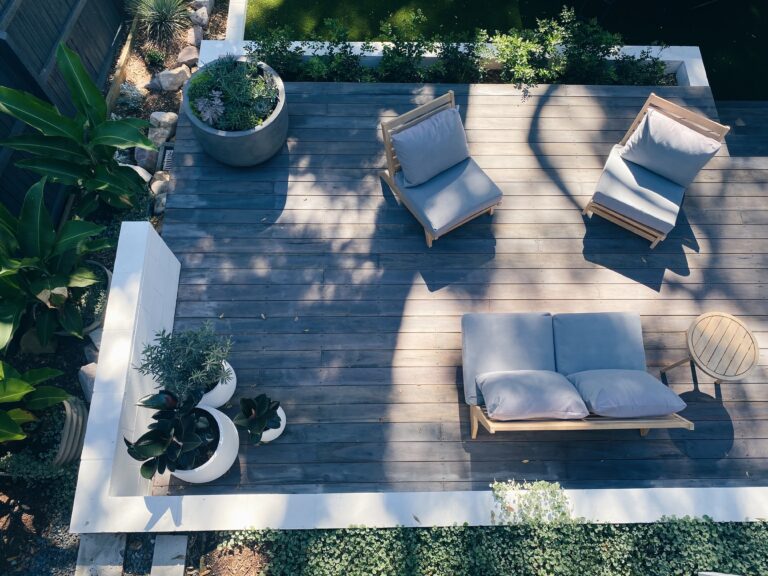Composite decking has gained popularity as a durable and low-maintenance alternative to traditional wood decking. Like any building material, it comes with its own set of challenges. In this article, we will explore the common problems associated with composite decking, such as fading and discolouration, mould and mildew growth, scratches and stains, warping and cracking, slipperiness when wet, heat retention, and cost considerations.
Understanding these issues is crucial for homeowners and builders to make informed decisions and take proactive measures to prevent or minimise these problems. Whether you are considering installing a new composite deck or already have one, this comprehensive guide will provide valuable insights on how to address and mitigate these common concerns effectively.

What Is Composite Decking?
Composite decking is a modern alternative to traditional wood decking, offering a durable and low-maintenance solution for outdoor spaces.
It is typically made from a combination of wood fibres, plastic, and binding agents, which results in a product that is resistant to rot, splintering, and insect damage. One of the key benefits of composite decking is its longevity, as it can withstand the elements without requiring regular staining or sealing. Composite decking is available in a wide range of colours and styles, providing homeowners with options that suit their outdoor aesthetic preferences. This makes it a popular choice for outdoor decking and materials, particularly in high-traffic areas where durability is essential.
How is Composite Decking Made?
Composite decking is manufactured through a process that combines wood fibres, recycled plastics, and binding agents to create a sturdy and weather-resistant material.
These raw materials are carefully selected to ensure durability and sustainability in the final product. The production of composite decking involves blending the wood fibres and recycled plastics with the binding agents, often under high pressure and temperature, to form a homogeneous mixture. This mixture is then shaped into boards of various sizes and profiles, catering to different design preferences.
Manufacturers play a crucial role in ensuring quality control throughout the manufacturing process, from sourcing the raw materials to the final inspection of the composite decking boards.
What Are The Benefits Of Composite Decking?
Composite decking offers exceptional durability, weather resistance, UV resistance, and low maintenance, making it an ideal choice for outdoor spaces.
It is engineered to withstand the harshest outdoor conditions, preventing warping, rotting, and splintering. This durability ensures a longer lifespan compared to traditional wood decking, saving homeowners the hassle and cost of frequent replacements. Its UV resistance prevents fading and discolouration, maintaining its attractive appearance for years. With minimal maintenance required, composite decking simply needs occasional cleaning to keep it looking pristine, allowing more time to relax and enjoy the outdoor living space.

What are the common problems with composite decking?
Whilst composite decking offers numerous benefits, it is susceptible to common problems such as mould, mildew, fading, warping, cracking, and staining, influenced by environmental factors and wear and tear.
These issues can arise due to the decking being constantly exposed to different climate conditions. The combination of moisture, sunlight, and temperature fluctuations can contribute to the growth of mould and mildew, as well as cause the colour to fade and the material to warp and crack.
Heavy foot traffic and the weight of furniture can accelerate wear and tear, leading to stains and surface damage. Addressing these challenges requires regular maintenance and proper care to preserve the longevity and appearance of composite decking.
Fading and Discolouration
Fading and discolouration are common concerns with composite decking, often attributed to prolonged UV exposure and the natural ageing process of the materials.
UV exposure plays a significant role in the colour fading of composite decking. The continual exposure to sunlight can lead to the breakdown of the polymers and pigments within the decking material, causing the colours to gradually fade. Environmental factors such as moisture, temperature fluctuations, and air pollutants can also contribute to the discolouration of the decking.
It is essential for manufacturers to address these challenges by enhancing UV resistance and developing advanced colour-fading technologies to ensure the longevity and aesthetic appeal of composite decking.
Growth of mould and mildew
The development of mould and mildew on composite decking is often linked to moisture retention and insufficient cleaning and maintenance practices.
It is crucial to ensure that the composite decking is regularly cleaned, as organic debris and dirt can create a conducive environment for mould and mildew growth. High levels of moisture, whether from rain, humidity, or improper drainage, can exacerbate this issue.
Implementing a proactive cleaning routine and effectively managing moisture levels through proper drainage and ventilation are key steps in preventing the formation of mould and mildew, ultimately prolonging the lifespan of the decking material.
Scratches and Stains
Scratches and stains can detract from the aesthetic appeal of composite decking, necessitating proper care and maintenance to prevent and address such issues effectively.
Regular maintenance tips such as:
- sweeping off debris
- cleaning with a mild soap solution
- using a soft-bristled brush
can help prevent scratches and stains from taking hold.
Promptly addressing any spills or stains and avoiding dragging heavy furniture across the surface can further preserve the decking’s appearance.
Implementing these proper care practices ensures that composite decking maintains its allure and durability for years to come.
Warping and Cracking
Warping and cracking in composite decking can result from exposure to fluctuating climate and humidity levels, emphasising the significance of adhering to proper installation guidelines and environmental considerations.
These factors play a crucial role in the long-term performance of composite decking. For instance, in regions with high humidity or rapid temperature changes, the expansion and contraction of the material can lead to warping. It’s essential for installers to carefully follow the manufacturer’s installation guidelines, ensuring proper spacing, fastening, and support structures.
By acknowledging the impact of climate and meticulously following installation instructions, homeowners can mitigate the risk of warping and cracking in their composite decking.
Slippery When Wet
Composite decking may become slippery when wet, highlighting the importance of selecting products with enhanced weather resistance and a reliable resin finish to mitigate this issue.
This is particularly crucial in regions where frequent rainfall or humid conditions prevail. The resin finish is a crucial factor in maintaining traction and preventing slips, while superior weather resistance ensures the longevity of the decking despite exposure to various climatic conditions. Investing in high-quality composite decking with these features not only prioritises safety but also contributes to the overall durability and performance of the outdoor space, making it a worthwhile consideration for homeowners seeking long-term value.
Heat Retention
Heat retention in composite decking can be influenced by environmental factors and climate, impacting its suitability for use in outdoor spaces, calling for consideration of the product’s heat resistance properties.
This is especially important in regions with high temperatures or intense sunlight, as excessive heat buildup in decking materials can impact their durability and performance. The choice of colour and surface finish can also play a role in heat retention, with darker shades absorbing more sunlight and potentially becoming uncomfortably hot. Therefore, selecting composite decking with enhanced heat resistance can contribute to a more comfortable and sustainable outdoor living environment.
Cost
The cost of composite decking, along with warranty coverage, potential replacement, and repair considerations, are crucial factors to evaluate for an informed decision-making process.
When considering the overall cost of composite decking, it’s important to factor in the warranty coverage provided by the manufacturer. Understanding the details of the warranty, such as the duration and what is included, can provide peace of mind regarding potential replacement and repair costs.
Taking into account the long-term durability and low maintenance nature of composite decking can contribute to a cost-benefit analysis, making it a viable long-term investment for homeowners.
How to Prevent/Minimise These Problems?
Implementing preventive measures, adhering to a maintenance schedule, and providing proper care are essential in minimising the potential problems associated with composite decking, ensuring its long-term quality and performance.
Regularly inspecting the decking for any signs of damage, such as cracks, warping, or mould, and promptly addressing these issues can prevent them from escalating into more significant problems. Cleaning the decking regularly with a mild soap and water solution, avoiding harsh chemicals that could damage the composite material, and promptly removing any debris or stains can help maintain its appearance and integrity.
Following a maintenance schedule that includes periodic deep cleaning, sealing, and re-staining, as recommended by the manufacturer, can further enhance the longevity and quality of the composite decking.
Regular Cleaning and Maintenance
Regular cleaning and maintenance routines play a pivotal role in preserving the appearance and structural integrity of composite decking, particularly in outdoor spaces exposed to various environmental elements. Without regular upkeep, composite decking can succumb to mould, mildew, and dirt build-up, leading to discolouration and deterioration of the material.
Regular cleaning helps to prevent the growth of algae and other organisms that can compromise the decking’s integrity. By incorporating a consistent cleaning schedule, homeowners can ensure that their composite decking remains in optimal condition, enhancing the longevity and aesthetic appeal of their outdoor living spaces.
Using Protective Coatings
Applying protective coatings on composite decking can enhance its weather resistance and prolong the lifespan of the surface, providing an additional layer of protection against common environmental stressors.
These coatings offer effective shielding against UV rays, preventing colour fading and surface degradation. They act as a barrier against moisture, inhibiting the growth of mould and mildew, which can compromise the structural integrity of the decking.
The coatings also contribute to easier maintenance, as they create a smoother, more durable surface, reducing the need for frequent cleaning and refinishing. Incorporating protective coatings offers a practical and economical solution to preserve the beauty and functionality of composite decking for years to come.
Proper Installation and Ventilation
Proper installation techniques and adequate ventilation are crucial factors in ensuring the longevity and performance of composite decking, particularly in varying climate and humidity conditions.
This becomes even more crucial as composite decking materials can expand and contract with temperature changes, and improper installation or lack of ventilation can lead to warping, buckling, or even mould and mildew growth.
In areas with high humidity, proper ventilation becomes essential to prevent moisture build-up, which can compromise the integrity of the decking material over time.
By following recommended installation practices and ensuring sufficient ventilation, homeowners can maximise the durability and appearance of their composite decking, regardless of their local climate and humidity levels.
Choosing High-Quality Composite Materials
Selecting high-quality composite materials for decking purposes, ideally backed by positive customer reviews and manufacturer reputation, is instrumental in ensuring long-term satisfaction and durability.
These materials offer superior resistance to weathering, rotting, and insect damage, making them an excellent investment for outdoor spaces. Customer feedback about the performance and longevity of composite decking materials contributes to informed decision-making. By prioritising the quality of the composite materials and considering the experiences of other homeowners, individuals can make a choice that aligns with their expectations for longevity and ease of maintenance.
Using Mats or Rugs in High-Traffic Areas
Placement of mats or rugs in high-traffic areas of composite decking can mitigate wear and tear, preserving the appearance and structural integrity of the surface in frequently used sections.
They offer a protective barrier between foot traffic and the decking material, reducing the impact of constant movement and potential damage over time. This simple addition not only extends the lifespan of the decking but also helps to maintain its aesthetic appeal.
Mats and rugs also provide a non-slip surface in areas prone to moisture or spills, enhancing safety for those using the deck.
Considering Climate and Weather Conditions
Considering the impact of climate and weather conditions is crucial in determining the suitability and performance of composite decking, particularly with regard to humidity levels and moisture exposure.
These factors can significantly affect the durability and longevity of composite decking materials. High humidity levels can lead to swelling and warping, while excessive moisture exposure may result in mould and mildew growth, compromising the structural integrity of the decking. Environmental factors such as temperature fluctuations and UV radiation can also impact the material’s appearance and stability over time. Therefore, evaluating the climate and weather conditions is essential for ensuring the long-term functionality and aesthetics of composite decking.
Comparing Costs and Warranties
Conducting thorough comparisons of costs and guarantees for composite decking products is essential in making informed decisions, considering long-term maintenance and potential requirements for replacement.
This scrutiny empowers homeowners to weigh the initial investment against the long-term benefits, potentially saving significant costs in maintenance and avoiding premature replacement. By evaluating guarantees, one can gain insights into the level of confidence manufacturers have in their products, offering assurance and peace of mind as they plan for the durability of their decking.
Considering the impact on long-term maintenance, these comparisons prove instrumental in ensuring that the chosen composite decking meets the desired aesthetic and performance requirements without a hefty long-term maintenance burden.







